Flexible. Authentic. Sustainable. Inclusive. Social. Future-Forward.
 Islands Café at California State University Channel Islands. Photo courtesy of Webb Foodservice DesignThe list of words connected to dining new builds and renovations in the college and university space go from menu-based to culturally significant. Somehow, foodservice operators continue to meet the elevated expectations in this heavily watched segment.
Islands Café at California State University Channel Islands. Photo courtesy of Webb Foodservice DesignThe list of words connected to dining new builds and renovations in the college and university space go from menu-based to culturally significant. Somehow, foodservice operators continue to meet the elevated expectations in this heavily watched segment.
If they’ve heard it once, they’ve heard it a thousand times: “Boy, the food was never like this when I was in college.” It’s a statement those in charge of foodservice in the higher education segment encounter frequently from parents visiting campus dining halls. And these days with students becoming even more food-savvy — whether it’s through eating out, traveling or social media — staying on top of trends and creating dining facilities that meet the younger generation’s expectations is more challenging than ever.
“The pressure is always on with collegiate dining projects to have an excellent program,” says Kerri Fitzgerald, principal at ColburnGuyette Foodservice Design. “They’re always asking how we can design for long-term flexibility and the latest trends, whether that’s more inclusive, convenient, sustainable, authentic — insert your buzzword here. Dining is constantly evolving at colleges and universities, and each new challenge always feels like a new opportunity to help them improve their program.”
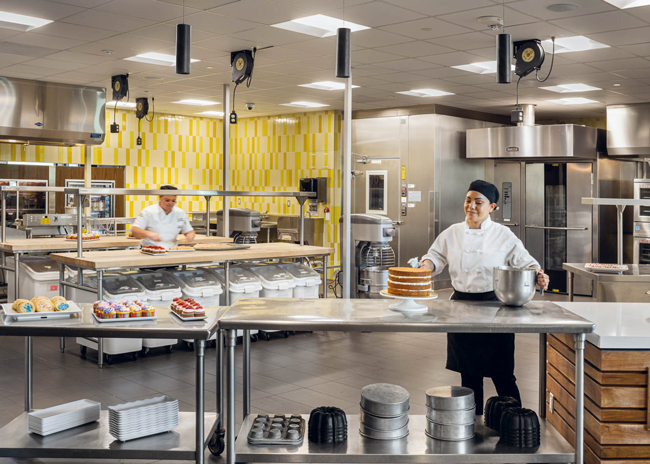 The back-of-the-house space at Glasgow Dining Commons at the University of California, Riverside, enables staff to deliver a residential dining program that includes a wide variety of freshly prepared foods and menu customization. Photos courtesy of Webb Foodservice Design
The back-of-the-house space at Glasgow Dining Commons at the University of California, Riverside, enables staff to deliver a residential dining program that includes a wide variety of freshly prepared foods and menu customization. Photos courtesy of Webb Foodservice Design
Campus Cuisine Variables
Across the board, operators and designers see not only a growing demand for cuisines from around the world but also the need to approach these menu items in ways that dig deeper into authentic flavors and ingredients.
“One of our largest focuses right now is offering menu items based off of our population of students from all over the world,” says Donald LaFlam, executive director of dining at New York’s Rochester Institute of Technology (RIT). In fact, Africa is a region that now ranks third for the university in terms of students’ home countries. As a result, RIT now offers more African, specifically West African, menu choices. “For us, it’s learning about those flavors to ensure those students have an experience they are engaged in.”
 The John J. Hemmingson Center at Gonzaga University provides students a modern environment where they can dine, study and build community all in one central campus location.At the University of Wisconsin-Madison, flavor stations that include a variety of spices and hot sauces help accommodate students seeking more meal customization and amped-up flavors. “We give the students the option to kick up the spice as much as they want or keep it a little bit more on the mellow side,” says Peter Testory, director of dining and culinary services. “Since spice can be subjective, this gives them the opportunity to choose their own adventure.”
The John J. Hemmingson Center at Gonzaga University provides students a modern environment where they can dine, study and build community all in one central campus location.At the University of Wisconsin-Madison, flavor stations that include a variety of spices and hot sauces help accommodate students seeking more meal customization and amped-up flavors. “We give the students the option to kick up the spice as much as they want or keep it a little bit more on the mellow side,” says Peter Testory, director of dining and culinary services. “Since spice can be subjective, this gives them the opportunity to choose their own adventure.”
At the University of California, Los Angeles (UCLA), an emphasis on health plays an integral role in the overall approach to foodservice. “Everything we do is focused on health,” says Al Ferrone, UCLA’s senior executive director of food and beverage services. “We are very conscious about the amount of meat we use and putting enough vegetables in every station.” Ironically, that led to doing away with programs like the ubiquitous meatless Mondays, which can often turn into “meat-full Tuesdays,” says Ferrone. “What we did is change the culture.”
Part of that change led to getting rid of many of the salad bars at UCLA and replacing them with composed salads. “Every station ought to be a complete meal,” says Ferrone. For example, Epicuria at Covel, a Mediterranean-focused concept, now serves pre-tossed Caesar and Greek salads. The concept has grown into one of UCLA’s highest-used outlets, Ferrone notes.
As part of RIT’s commitment to health, it has pledged that foodservice programs will consist of 50% plant-based options by 2025. That commitment comes with a caveat: “To make that claim, not only do we have to be strategic about how we set up each one of our platforms, but the other dynamic is making sure we have staff that’s trained to be able to execute it,” says Kory Samuels, associate vice president of auxiliary services, finance and administration.
Working through the dynamics of that pledge is already underway, Samuels adds. “We’re always trying to make sure that, outside of sides, there’s a plant-based protein available at each one of menu platforms — be it barbecue, a grill, a fry area or whatever.”
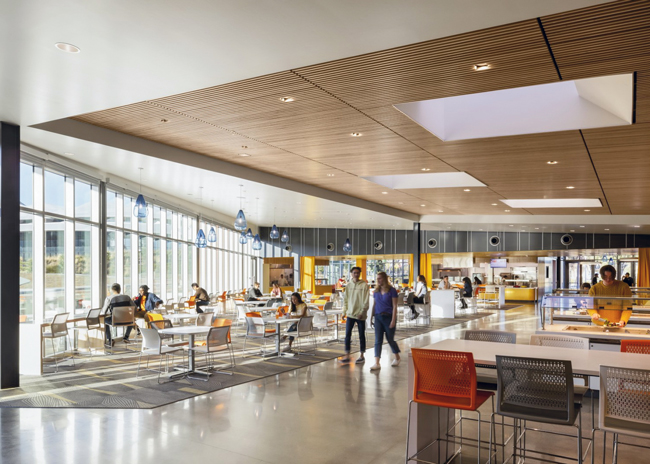 Centerpointe Dining Commons at Cal Poly Pomona was designed to build a sense of on-campus community.
Centerpointe Dining Commons at Cal Poly Pomona was designed to build a sense of on-campus community.
Less-Experienced Labor
Foodservice staffing continues to be an issue for higher ed but not in the way it used to be. “We are getting there to be fully staffed, but the skill level in the food industry has completely dropped,” says Rahul Shrivastav, executive director of dining and hospitality at Indiana University (IU) in Bloomington, Ind.
Testory agrees: “We’re not experiencing the labor shortages that we were one to two years ago, but what we are experiencing is a labor pool that’s not as experienced.”
For Samuels, recruitment and retention for RIT dining programs are two areas that are top of mind. As he considers technology he says, “We have to look at training and professional development as a paramount area that you have to invest in.”
An in-house culinary program that UCLA created has helped its labor situation both in numbers and level of expertise. “We take people with little or no experience, and we put them into a culinary program,” says Ferrone. The program includes six months of instruction, and participants receive a UCLA certificate upon completion. Of the 43 people who have graduated from the program, only one no longer works at UCLA.
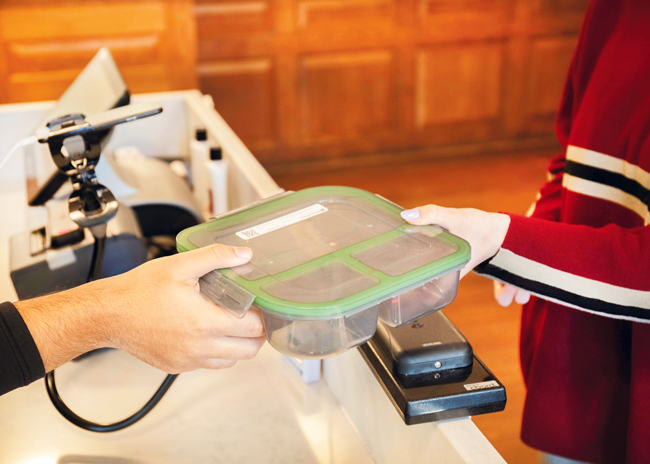 Reusable to-go containers are just one way IU focuses on sustainability.
Reusable to-go containers are just one way IU focuses on sustainability.
One approach that Fitzgerald takes to counter labor issues as a foodservice designer is being hyper-focused with her clients on back-of-the-house flow of product and personnel as well as spatial efficiencies. “For the most part, the question is no longer how many people would you ideally have, but more along the lines of how many people are you making it work with and understanding that labor is key to improving layouts and selecting equipment that will support a more efficient and effective operation,” she says.
Flow is also top of mind for Robin Hungerford, associate principal, planning director at Webb Foodservice Design. “As square footage gets squeezed, we need to be really mindful of just using every linear foot of that kitchen and storage space as much as we can,” she says. If a client says they are going to do a bakery, for example, she follows up with specific questions to determine what that means exactly. “Bakery is a pretty broad term, right? Are you baking bread? Are you baking cookies? Are you baking dessert bars? What level of pastry baking are you doing?” she asks. Based on the answers, she works to ensure that area is right sized for what the client plans to do. “We don’t want to undersize something, but we also don’t want to overbuild it either.”
From a front-of-the-house perspective, Testory finds that Wisconsin’s legacy with stations spread out across the space is becoming harder to manage. “With the labor pool the way that it is, it’s important to not spread your resources and instead keep them as centralized as possible.”
When it comes to equipment in relation to labor issues, buying pieces that are versatile is key. “At RIT, we started making a big investment a few years ago to minimize some of our standard convection ovens and steamers and move to combi ovens,” says Samuels, which he says also gives the staff more control over quality.
Adds LaFlam, “That piece of equipment has changed the way [RIT staff] operate and almost feels like an additional chef.”
Flexibility was also important when it came to improving the setup of RIT’s kitchens. Previously, most of the kitchens’ power outlets were located on the walls and floors. Moving power sources overhead now offers versatility over time, particularly in their larger foodservice operations. “It’s not a big thing, but it’s one that behind the scenes definitely helps you be that much more efficient,” says Samuels.
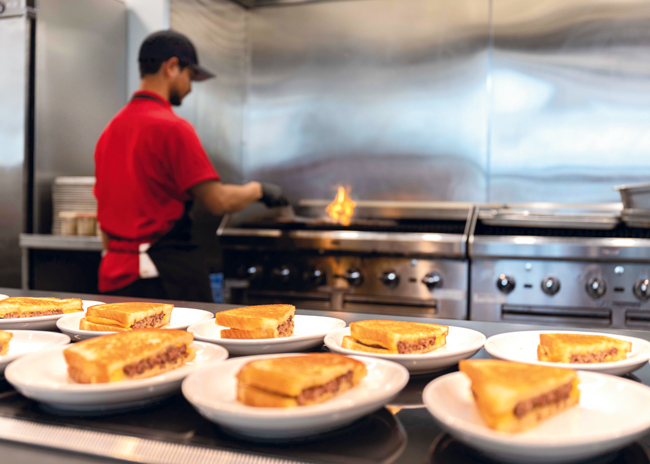 At Indiana University, offering food that connects with the almost 100 different cultures that make up its student body is vital.
At Indiana University, offering food that connects with the almost 100 different cultures that make up its student body is vital.
Tech Thoughts and Trials
Technology’s increased presence both in the back and front of the house continues to be a focal point for operators and designers. But with so much out there, choosing the right types can be tricky.
At UW-Madison, Testory is intrigued with automated make tables in which a kiosk-type ordering system selects ingredients, located above the table, which are then automatically dispensed into a bowl underneath the various dispensers. “One of the things we’re really looking at, however, is will that work when we have 600 students that are in between classes?” he says.
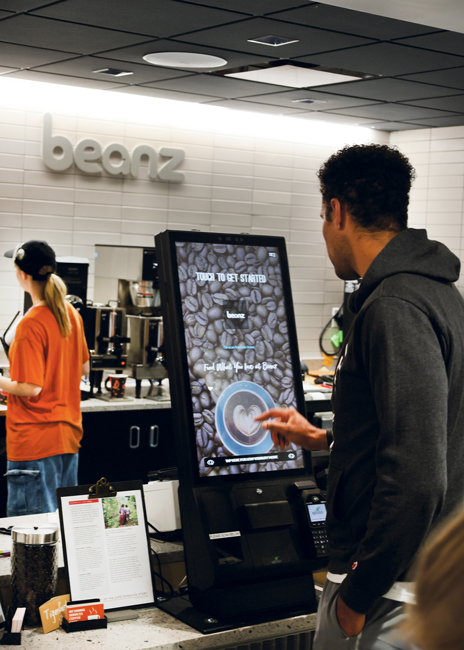 Touch-screen technology provides the university easy access to data that can be used to access changing food trends quickly.Fitzgerald is exploring robotics when it comes to food prep for her operator clients. “I read an article that estimated about half of foodservice employees’ time was spent doing tasks that could potentially be automated,” she says. “But it’s not just filling that long-open position. It’s also about ‘Wouldn’t it be nice if we could free up some of the human employees’ time to do more meaningful work and allow the robots to do the more dull and repetitive tasks?’”
Touch-screen technology provides the university easy access to data that can be used to access changing food trends quickly.Fitzgerald is exploring robotics when it comes to food prep for her operator clients. “I read an article that estimated about half of foodservice employees’ time was spent doing tasks that could potentially be automated,” she says. “But it’s not just filling that long-open position. It’s also about ‘Wouldn’t it be nice if we could free up some of the human employees’ time to do more meaningful work and allow the robots to do the more dull and repetitive tasks?’”
Aside from equipment, Fitzgerald notes that an increased interest in craft beverages on tap, such as cold-pressed juices, artisanal sodas and flavored waters, plays into future equipment selection.
RIT’s LaFlam predicts AI will blow up for C&U foodservice in the next five years when it comes to inventory management, scheduling and purchasing. “That could drive a lot of processes and overall operational effectiveness,” he says.
Incorporating technology when it comes to cleaning processes is an area where Hungerford sees potential for growth. “But what we have to decide on each project is, ‘Is it the right decision for this project?’ so we don’t get distracted by the new shiny thing, put it in and come back two years later and our clients basically unplugged it and put it on the dock to die.”
Mobile ordering continues to be a priority for colleges and universities.
The mobile ordering app at UCLA lets students know how long their food will take and notifies them when it’s available. The school is also using technology inspired by an app that libraries use; it pings all of the cell phones in the dining halls and lets students know how busy they are. “The biggest thing we see is the time stressor for students,” says Ferrone. “They’re busy studying, and we want to make sure they’re not spending time waiting.”
Students at RIT have access to similar technology where they can see details about the progress of their order and receive a text message when it’s complete. Within the last year, ordering kiosks have been added. Additionally, the school has leaned into being more data-driven, says Samuels. “When you have people order in those environments, it naturally can create scenarios of understanding what trends are happening on your campus,” he says.
But mobile ordering does come with some additional considerations. “Yes, students are looking for fast, fresh, frictionless dining options that are on the go,” says Fitzgerald, “but dining is still about bringing a community together so there must be some kind of balance between that convenience factor and you still
breaking bread together.”
C-stores, while not new on most campuses, are experiencing some innovations. At UW-Madison, Testory has been looking at healthier options beyond the standard chips and candy bars. International snacks, especially Asian ones, are on his radar too.
Shrivastav took more of a low-tech approach to the payment process at IU’s c-stores. “When COVID happened and everybody was like high-tech this, high-tech that, that wasn’t easy for us to do at that time,” he says. “Instead, we turned around the scanners, so the student does it.” It’s a process that continues to work. “They [the students] are very honest and focused on doing the right thing.”
The university has gone more high-tech when it comes to helping students with allergies or specific diets. At three of IU’s dining facilities, digital signage has been installed that allows students to use their smartphones and scan for detailed info on allergens, ingredients and the dish’s recipes. “Transparency is very important to us,” says Shrivastav.
At UW-Madison, mobile ordering apps help the school accommodate students with dietary restrictions. “We give them a wide array of options to choose from and enable them to order their food ahead so that when they come in, they’re able to get their food and go sit at the table like their friends do,” says Testory.
 UCLA takes its foodservice program seriously, including creating two cookbooks, in one of which this beet-centric dish appears.
UCLA takes its foodservice program seriously, including creating two cookbooks, in one of which this beet-centric dish appears.
New Views on Sustainability
Finding new and better ways to be sustainable is another topic that continues to be top of mind for foodservice operators and students.
 The University of Wisconsin-Madison mascot Bucky Badger walks a student through touch-pad ordering. When it’s completed in 2025, the renovation of one of IU’s largest and oldest dining rooms will include a dish room and dish return area that allow for the use of reusable dishware instead of disposable items. Additionally, the school switched its meal plans from a retail/a la carte approach to all-you-care-to-eat dining. Gone too are trays, a move that has been successful in reducing food waste, says Shrivastav.
The University of Wisconsin-Madison mascot Bucky Badger walks a student through touch-pad ordering. When it’s completed in 2025, the renovation of one of IU’s largest and oldest dining rooms will include a dish room and dish return area that allow for the use of reusable dishware instead of disposable items. Additionally, the school switched its meal plans from a retail/a la carte approach to all-you-care-to-eat dining. Gone too are trays, a move that has been successful in reducing food waste, says Shrivastav.
It’s a similar scenario at UW-Madison, which switched in 2022 from a 100% retail/declining balance model to a trayless all-you-care-to-eat model. “We wanted to remove the trays to help limit food waste as much as possible,” says Testory. Reusable containers are part of the school’s to-go program.
The foodservice operations recently partnered with the office of sustainability to launch a food-waste tracking system, which is now in two of its facilities with plans to roll it out to more locations. “We can really look at what’s being wasted,” Testory says. At this stage, it’s primarily pre-consumer waste, meaning the overproduction of food, and the school hopes to dive into the post-consumer waste in the future.
Food waste management is growing more and more creative, Fitzgerald says. Some of her clients are partnering with local farmers who feed the school’s food waste to their livestock. “Finding the right fit, process and equipment for each project is always more interesting than just checking the box for an Energy Star piece of equipment,” she says. “It’s never one size fits all.”
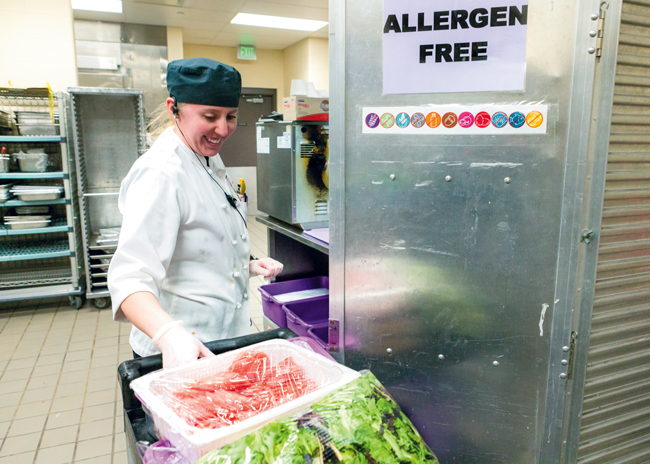 Dietary restrictions, whether it’s due to allergies or culture, are a big part of of the university’s foodservice program.Nearly all of Fitzgerald’s projects include either all-electric equipment or are “electric-heavy,” a term she coined to refer to projects with only a handful of gas equipment items that aren’t easily replaced with an electrical alternative, such as a charboiler.
Dietary restrictions, whether it’s due to allergies or culture, are a big part of of the university’s foodservice program.Nearly all of Fitzgerald’s projects include either all-electric equipment or are “electric-heavy,” a term she coined to refer to projects with only a handful of gas equipment items that aren’t easily replaced with an electrical alternative, such as a charboiler.
At the end of the day, though, one issue that continues to plague all of the operators and designers we spoke with — and really, everyone — is the rising cost of doing business. “It’s continuing to have to do more with less,” says Testory. “Because while we might have less funds for whatever reason or things are getting more expensive, our students’ expectations are not going to go down to match that, so we need to continue to find ways to offer the program we want.”
“For operators it’s more about how you continue to keep pushing the envelope but make enough funds to be able to reinvest in yourself,” says Samuels. “The way, financially, we operated even five years ago, is dynamically different now. You have to really peel back the layers and prioritize what you can and can’t do in a different way.”
Hungerford spends a lot of time with her clients discussing how many foodservice platforms they truly need and approaching projects from a quality-over-quantity perspective. “If we can have an honest conversation about those things, we can get to a point where we’re designing something that’s practical but set up to deliver a better financially run operation and a better guest experience,” she says. “We do need to reality check ourselves and realize you don’t have to be everything all the time.”



